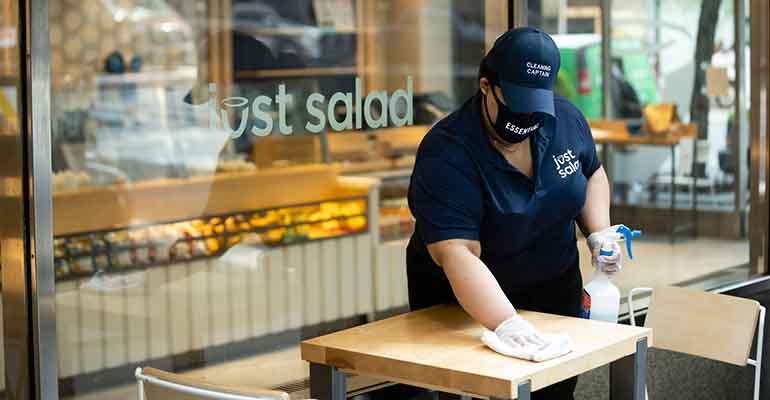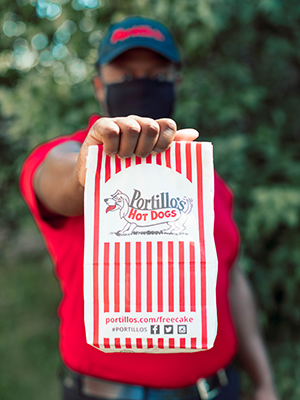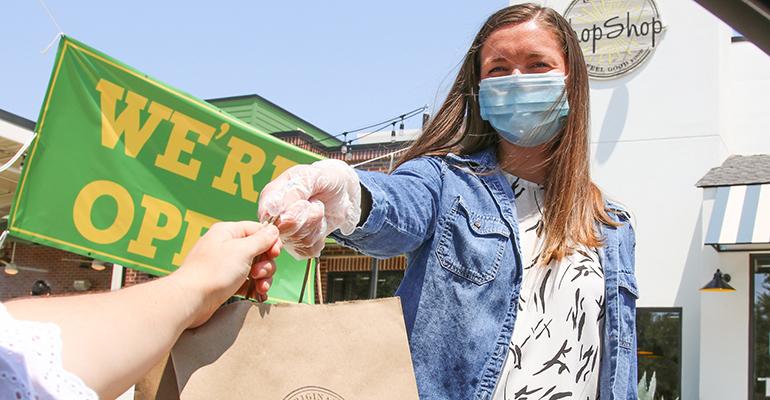This is part of our Workforce package that appeared in the 9/21 issue of Nation's Restaurant News. Read more about the labor market, compensation and diversity and inclusion here.
As restaurants begin to rehire employees they lost at the beginning of the COVID-19 pandemic, the workforce is looking very different than it did pre-coronavirus.
Foodservice job board are reflecting a renewed focus on off-premise services, crowd management and health and safety. For many employees returning back to work after being furloughed or laid off, they are finding that restaurants have shifted their focus: They may be hiring more delivery drivers than servers, more drive-thru workers than cashiers, and completely new positions have opened up like, sanitation captains and food-safety officers.
“What we’re seeing right now in foodservice is sanitation being ramped up like never before and there are emerging roles that we had not seen before,” said Scott Knaul, executive vice president of retail and hospitality with Workforce Insight, a workforce management firm. “Now that every restaurant is doing curbside pickup, you have people whose only job is to run food from kitchen out to cars. And in almost a contradictory way, other restaurants are hiring all-purpose employees who multitask and are cross-trained to do practically everything in the restaurant.”
Despite the job demand both on the hiring and employee sides, restaurant industry turnover is higher than ever, mainly due to safety-and-health concerns in and out of the workplace, according to hiring platform Workstream. Because of this trend, the hiring, training and onboarding processes work differently now.
“We’re seeing more hires for broad titles such as crew member and team member,” said Lydia Fayal-Hall, head of growth at Workstream. “They have added new steps to the training process: new hires start by managing the front door to temperature check people and make sure they are wearing masks. The second stage is cleaning and sanitizing, and then if they make it to the third month, they learn more skills.”
But even with jack-of-all-trade positions on the rise at restaurants, many companies are looking for specific skills when hiring (or rehiring) employees. Here’s a look at four new COVID-era foodservice jobs from five companies that have pivoted during the pandemic.
Food Safety Officer
Chicago-based, Compass Group/Eurest-owned restaurant incubator Foodworks — which brings small, local foodservice brands to business venues in 23 cities — needed an easy way to standardize health-and-safety procedures across all of its brands once the pandemic began. That standardization came in the form of hiring food-safety officer Tamara Mullin to develop and help train their operators on health-and-safety standards. Mullin — with 30 years of experience in foodservice focusing on food safety — was hired in 2019 and since the pandemic began has shifted her job to focus almost entirely on scheduling COVID-19 training with every vendor and following up to ensure compliance.
Mullin has developed COVID-19-era educational training in the form of webinars, handouts, posters and guidelines. Before the pandemic hit, her job might have entailed flying around the country to check on vendors in person, but now most of her compliance checks are done virtually.
“Our training is much different now than it was before,” Mullin said. “We have to regulate temperature checks, contactless service, face masks, social distancing, and more. We review hand washing and temperature logs and have a toolkit for vendors to use that provides operators with vital information, like a high-touch surface checklist for cleaning. A lot of these people are down to bare bones, so we want to provide a one-stop-shop for them opening back up.”
The biggest challenge, Mullin said, is that every city, state, and county handles COVID-19 procedures and regulations differently, particularly for B&I vendors like those that work with Foodworks.
“Having this position allows me to reach to these places to find out correct way to operate our particular type of foodservice,” she said. “A lot of cities don’t have regulations yet for operations like ours.”
Sanitation Captain
One common need for all restaurants in the COVID era is constant sanitation.
At Frisch’s Big Boy — the 117-unit casual-dining chain based in Cincinnati — they have hired cleaning captains at every location. Many of these new cleaning captains were internal hires of employees that were laid off earlier in the pandemic. They wear cleaning captain shirts and are often seen “sanitizing high-contact areas” and making sure the restaurants are following hospital-level cleaning protocols, said Chris Ford, vice president of operations at Frisch’s Big Boy.
“Our guests feel that we’re protecting them and taking necessary steps at this time,” Ford said. “The pandemic was a wakeup call. This is something we should have always been doing and now everyone is on heightened awareness. The cleaning captains will be permanent and as they get better at their job, their duties will only increase.”
 Frisch’s Big Boy is not the only company to introduce cleaning roles. New York City-based, more than 40-unit Just Salad has also introduced a cleaning captain to their stores in July. Their job is to clean both customer-facing and employee-facing surfaces every 20-30 minutes, with high-traffic areas being their top priority.
Frisch’s Big Boy is not the only company to introduce cleaning roles. New York City-based, more than 40-unit Just Salad has also introduced a cleaning captain to their stores in July. Their job is to clean both customer-facing and employee-facing surfaces every 20-30 minutes, with high-traffic areas being their top priority.
“The conversation with our managers was that we don’t want this to be a fad in the industry; we want this to be an actual position where we take ownership and pride in making sure our stores are safe for the guests and all of the team members who work in our stores,” Apolinar Chavez, chief operating officer at Just Salad said in July.

The role of cleaning captain was introduced at Just Salad.
Delivery Driver
Delivery drivers have been around since the start of takeout culture in America, but until the pandemic began, many restaurants were leaning on third-party delivery as off-premise solutions. Now, restaurants like 63-unit Chicago-based beef and hot dog chain Portillo’s are trying their hand at in-house delivery for safety and quality control purposes.
At the beginning of the pandemic, Portillo’s made the decision to not lay off workers, but they did take a few weeks to cross-train their employees in new pandemic-era positions, like curbside pickup runners and hosts to make sure the drive-thru and all off-premise options are running smoothly.
Before COVID-19 hit, Portillo’s was thinking of also adding in-house delivery, but the pandemic just sped up the process. Out of 285 drivers that they have hired over the past few months, most of the hires have been internal. That way, director of training John Isbell said, they can also cross-train them to work in the restaurant.
The difference between the uncertainty of a third-party delivery order and a guest anticipating an in-house delivery straight from Portillo’s is significant, he said.
 “It's our responsibility to give our guests the best possible experience,” Isbell said. “You open the door and you see a Portillo's delivery person and that makes a difference."
“It's our responsibility to give our guests the best possible experience,” Isbell said. “You open the door and you see a Portillo's delivery person and that makes a difference."
Isbell said that their in-house delivery ended up becoming “an extension of the brand” and that they will be adding delivery for dinner after their successful run of the lunch daypart. Training and onboarding cost of in-house delivery ended up being cost-neutral for the company because they were no longer paying third-party delivery fees.
Similarly, Original ChopShop — a 15-unit, Dallas-based, fast-casual salad and bowls concept — also tried to keep their staff during the tough early days of the pandemic. Despite the challenging times, ChopShop took the opportunity to improve their customer relationships by ditching third-party delivery in favor of in-house delivery. Instead of laying off workers, ChopShop retrained 80 employees as delivery drivers.
 “We immediately saw a significant increase in orders,” Jason Morgan, CEO of ChopShop said, adding that they launched their mobile app in August, which also boosted sales.
“We immediately saw a significant increase in orders,” Jason Morgan, CEO of ChopShop said, adding that they launched their mobile app in August, which also boosted sales.
ChopShop is working with technology management company Onfleet, which offers last-mile delivery services to restaurants. Through them they were able to get the commercial driving certifications needed and automate the process of training their employees.
“We control the experience from beginning to end now and can assure customer satisfaction,” Morgan said. “We found that if a customer orders directly from us they can get their food 15 minutes faster than if they ordered through third-party and it’s 25% less expensive. We also can capture guest data now and we’re in control of that.”
At this point, ChopShop will be hiring external delivery drivers to meet with ongoing demand. The changes, Morgan said, will be permanent because customer expectations have gone up.
Dining Room and Bar Ambassador
Frisch’s Big Boy did not just hire sanitation captains; they also created dining room and bar ambassadors to replace their usual servers and buffet attendants. Before the pandemic began, guests could help themselves to the breakfast bar and salad bar, but now they order their food up front, choose their own tables and the dining room ambassadors bring out their order. The bar ambassador, meanwhile, serves food from the breakfast and salad buffets, sanitizes the bar area and swaps out utensils every 15 minutes.
“By cutting out the server it allows us to adhere to social distancing and eliminate unnecessary close contact, but they are still getting great service,” Ford said, adding that the former servers now make better wages because of the move away from tip-credited positions in the dining rooms.
Contact Joanna Fantozzi at [email protected]
Follow her on Twitter: @joannafantozzi





